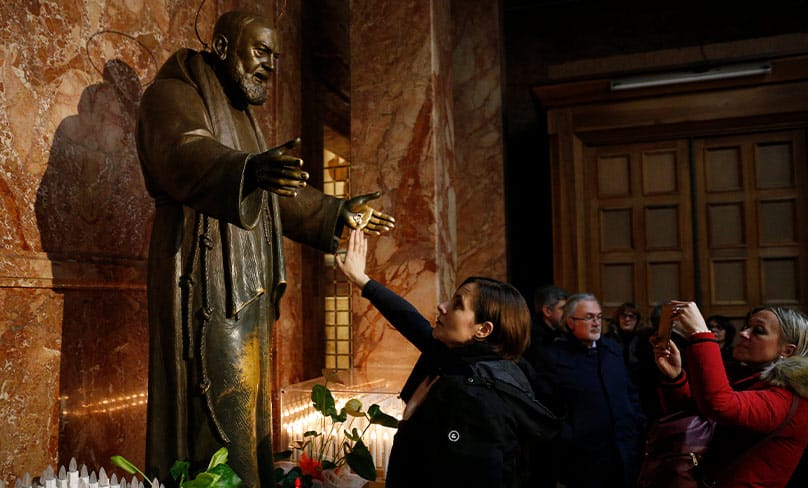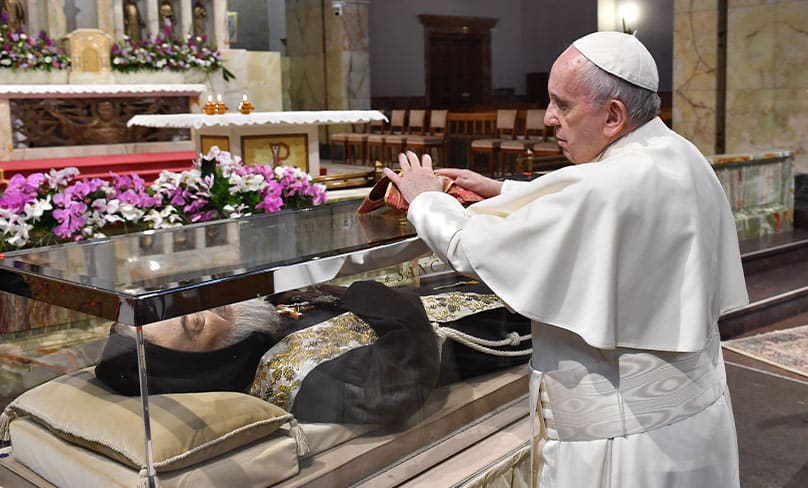
“Dear Father, I was recently invited to attend a prayer group devoted to St Padre Pio and found this saint very inspiring. I’d be grateful if you could tell me more about who he was and what made him such a popular saint.”
Padre Pio, or more properly St Pio of Pietrelcina was a popular saint indeed, regarded widely as a saint already in his lifetime.
Although he died as recently as 1968, he was canonised by Pope St John Paul II in 2002 and his feast day was quickly incorporated into the Roman missal to be celebrated by the universal Church.
There are thousands of prayer groups devoted to him all over the world.
Padre Pio, born Francesco Forgione on 25 May 1887 in the Italian town of Pietrelcina in the south of Italy, was the fourth of eight children.
His parents Grazio and Maria were peasant farmers and deeply religious, attending Mass daily, praying the rosary every night and abstaining from meat three days a week.
Padre Pio said that when he was five he had already decided to dedicate his whole life to God and that from his youth he experienced heavenly visions of Our Lord and Our Lady.
When he was 10 he felt drawn to the life of the Capuchin Franciscan friars but his parents were told that he should receive more education first.
In 1903 at the age of fifteen Francesco entered the novitiate of the Capuchin friars at Morcone, near Pietrelcina, where he took the religious name of Fra Pio in honour of Pope Pius I, whose relic was venerated in the Santa Anna Chapel in Pietrelcina.
Despite suffering considerable ill health, he was ordained a priest in 1910. After six years living with his family because of his health, in 1916 Padre Pio was sent to the Capuchin friary in San Giovanni Rotondo, where he lived until his death in 1968 and where his remains are venerated.
Padre Pio was very devoted to the Rosary and he recommended meditation and self- examination twice daily: in the morning to prepare for the day and in the evening to examine how it went.
He also recommended weekly confession, which he compared to the weekly dusting of a house. His five rules for spiritual growth were weekly confession, daily Communion, spiritual reading, meditation and examination of conscience.

He led an austere life of fasting and penance, and he had the wounds of Christ, the stigmata, on his hands, feet and side from 1918 until his death fifty years later.
He wore mittens or black coverings on his hands to hide the wounds, which bled and gave him intense pain, such as Christ would have felt on the Cross. The wounds gave off a pleasant smell, as of flowers.
Padre Pio was also known for such spiritual gifts as healing, bilocation, ecstasy, levitation and prophecy. He was especially known for his long hours in the confessional and for knowing aspects of a person’s life he could not have known by human means.
The devil attacked him both physically and spiritually, as he had St John Vianney, the Curé of Ars.
For a number of years Padre Pio was forbidden to say Mass in public and to hear confessions, something that cost him dearly but which he accepted as coming from the hands of his mother the Church.
Finally, in 1933 Pope Pius XI ordered the ban to be lifted, saying that he had been badly informed about Padre Pio.
Padre Pio’s health deteriorated in the 1960s but he kept up his spiritual work, especially hearing confessions.
On 21 September 1968, the day after the fiftieth anniversary of his receiving the stigmata, he felt very tired. The following day he was supposed to offer a Solemn Mass, but because of his weakness he asked his superior if he might say a Low Mass instead.
Due to the large number of pilgrims present the superior decided that he should say the Solemn Mass, which he did with great effort, appearing extremely weak and with a faint voice. This was to be his last Mass.
Early in the morning of 23 September, Padre Pio made his last confession and renewed his Franciscan vows. With the rosary in his hands he repeated the words “Jesus, Mary” until he finally breathed his last. Over 100,000 people attended his funeral on 26 September.
He was beatified by Pope St John Paul II in 1999 and canonised in 2002. Some 300,000 people attended his canonisation ceremony in Rome. His feast is celebrated on 23 September.
